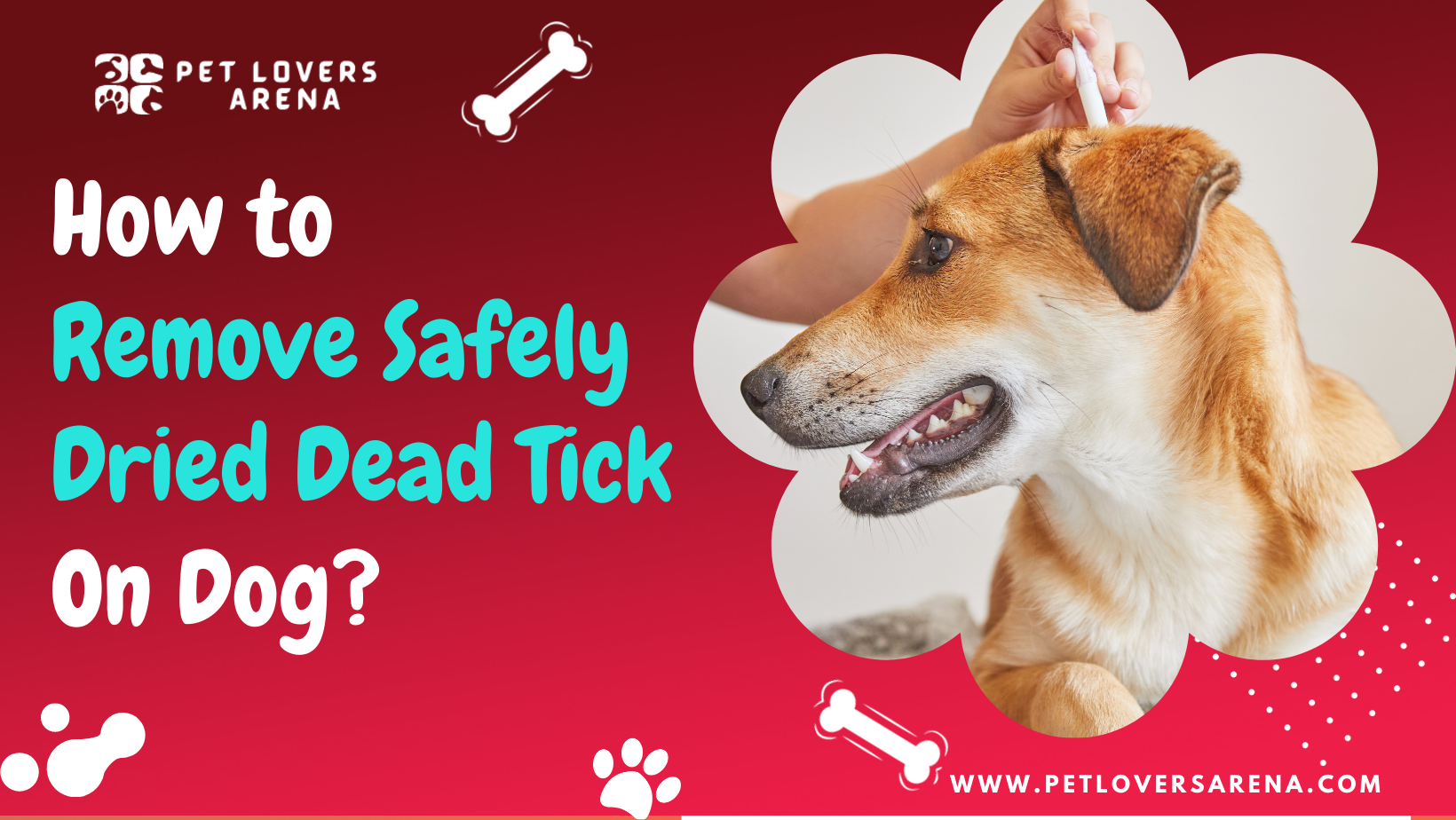You will find dried, dead ticks on your dog, especially during the spring and fall. But dead ticks are as distressing as finding live and stuffed ones. Dead ticks are parasites that usually suck blood off your dog. They can even cause illnesses like Ehrlichiosis, Lyme disease, and Anaplasmosis.
Although they are less threatening than the live ones, dead ticks must be removed promptly. Dog parents have to battle with ticks constantly.
If it’s the first time you’ve caught sight of a dead tick, don’t panic. You have to understand how your buddy got the ticks and what you can do to remove and prevent them.
In this article, you will find out all the necessary information, facts about ticks, and the best ways to deal with the dead ones on your dog. Keep scrolling down!
What Are Dead, Dried Ticks Found On Dogs?
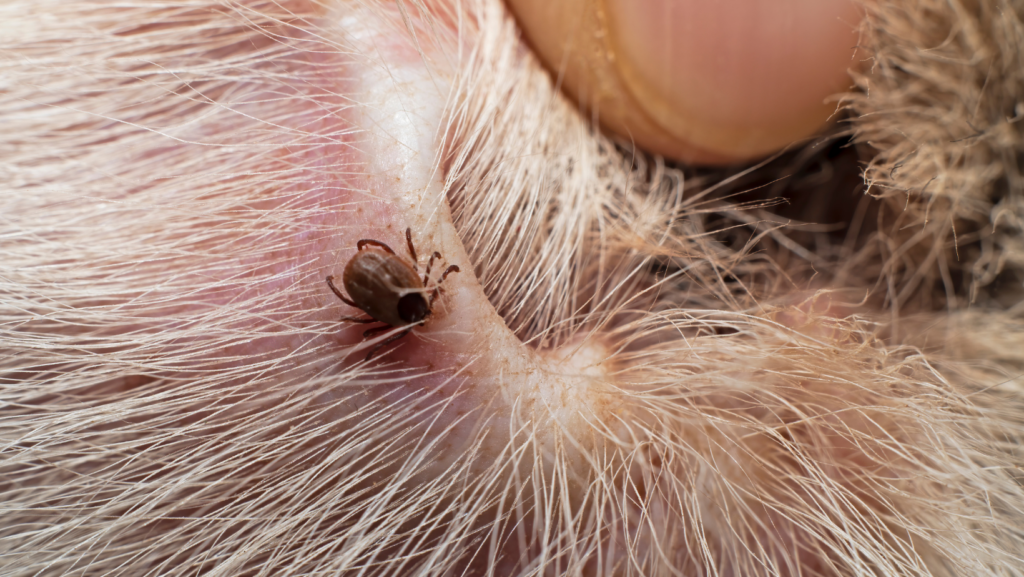
Dead, dried ticks are insects that attach to feed themselves on the host body and die accidentally. In this case, the host body is your dog. These dead ticks gradually shrink and dry up while still remaining embedded in your buddy’s skin. In thick dogs, they usually go unnoticed.
These parasitic insects can be of different sizes and appearances based on their species and, often, on the amount they feed before dying. However, dead ticks can cause little to no damage to your pet’s health.
Generally, dog ticks can lead to several infections or diseases that may also infect humans. So it’s better to deal with it promptly, whether it’s alive or dead.
If you don’t remove dead ticks quickly, your dog can suffer from redness and irritation.
How Do Dead Ticks Appear in Dogs?
Dead dog ticks appear flat, shriveled, and unmoving with stiff legs. They often stick firmly to a dog with their mouthpieces intact. You can confirm whether the tick is alive or dead by checking for movement.
In addition, these insects look red, grayish, silvery, or brown. They don’t look swollen up like live ticks. While they insert their teeth deep inside a dog’s skin, they can cause skin problems and irritation. Once you establish that your dog has dead ticks, remove them using fine-tipped forceps.
On the other hand, dead ticks will feel like tiny bumps on your pet’s skin. In long-coated dogs, these insects are harder to notice. You will notice them during regular coat maintenance, such as brushing. However, they appear mostly on a dog’s belly, head, neck, ears, and feet.
Are Dead, Dried Ticks Harmful to Dogs?
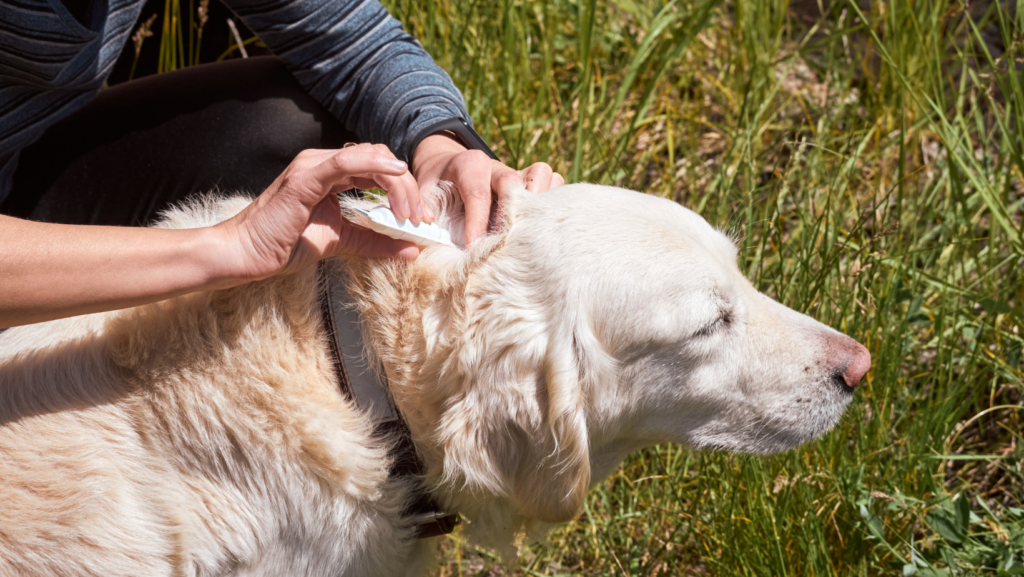
Dead, dried ticks are typically less harmful than live ones. Your dog won’t suffer from fatal or severe diseases because these ticks are dead. Nevertheless, it’s still essential to eradicate them, especially if they’re embedded in the dog’s skin. Otherwise, it can lead to tick-borne afflictions, redness, irritation, itching, or any alarming skin conditions.
Dead ticks aren’t as harmful as live ones. But still, you should remove them quickly from your dog, as they can cause certain skin issues.
If you are dealing with dead ticks for the first time, the steps below will help you in the process. These step-by-step instructions will help you successfully remove both dead and live ticks from your dog’s skin.
Things You Need:
- A pointed tweezer with a sharp and thin end (or any other recommended tick-removal tool)
- A pair of disposable gloves
- Paper towel and a Ziploc or plastic bag
- 70% rubbing alcohol to use as an antiseptic.
Step-by-step Instructions:
If you follow the step-by-step method it makes it easier to remove dried tick on dogs. Here are the crucial steps to do so.
Step 1: Pinpoint the dead, dried tick
If your dog is long-coated, it can be challenging to pinpoint these bloodsuckers. You part their hair by brushing and checking properly. You can spot a dead tick anywhere on your buddy’s body, like the head, belly, ears, mouth, nose, and neck. You may even locate it under his paws and legs.
However, you must ensure that the bump you notice or feel is a tick and not a wart or skin tag.
Step 2: Remove the dead tick with a tweezer

Now it’s time to remove the dead tick you located on your dog’s skin. For your hygiene, wear gloves before starting the removal process. It will protect you from touching the dead tick.
In case your buddy has thick or long hair, part their hair so you can see and grip the bloodsucker properly. Take the pointed tweezer and go closer to their skin to grasp the tick firmly. Then, tug it delicately straight up from the skin after putting steady pressure on the parasite.
Make sure not to pull or twist it too hard. Be patient until it detaches from your buddy’s skin! Don’t worry if a tiny part of their skin also comes off with the tick. While the parasite inserts its teeth into the skin to suck blood, a tiny skin piece can also come off.
However, keep in mind that you must keep your hand steady while holding the tweezers. Otherwise, you may squeeze, puncture, or squish the tick with the tweezer.
It’s better to avoid puncturing the parasite, as its body will release the toxin onto your dog’s skin or bloodstream, causing serious infections. It might even cause irritation or redness, eventually resulting in hair loss due to consistent scratching or rubbing.
Was the tick’s head or mouth still attached to the skin while the body broke off? Try to pull it out with the pointed tweezer. If you can’t still remove it, don’t keep trying, as it can hurt your buddy. Instead, leave it. The head will naturally fall apart from your dog’s body.
Step 3: Clean the affected area
After removing the tick, you must clean the affected area to disinfect any harmful bacteria, if any.
Professionals recommend using hydrogen peroxide or 70% isopropyl rubbing alcohol. Use any of these as antiseptics to thoroughly clean and disinfect the bite area and surrounding areas.
However, you may also notice that your dog’s skin is sore and red after removing the tick. Don’t worry! Just put any antiseptic ointment like Neosporin on the affected area. Besides disinfecting the wound, it will also soothe the affected area.
Make sure that you also clean and sanitize the tweezers after using them. In addition, discard the used gloves.
Step 4: Put the dead, dried ticks into a bag or container
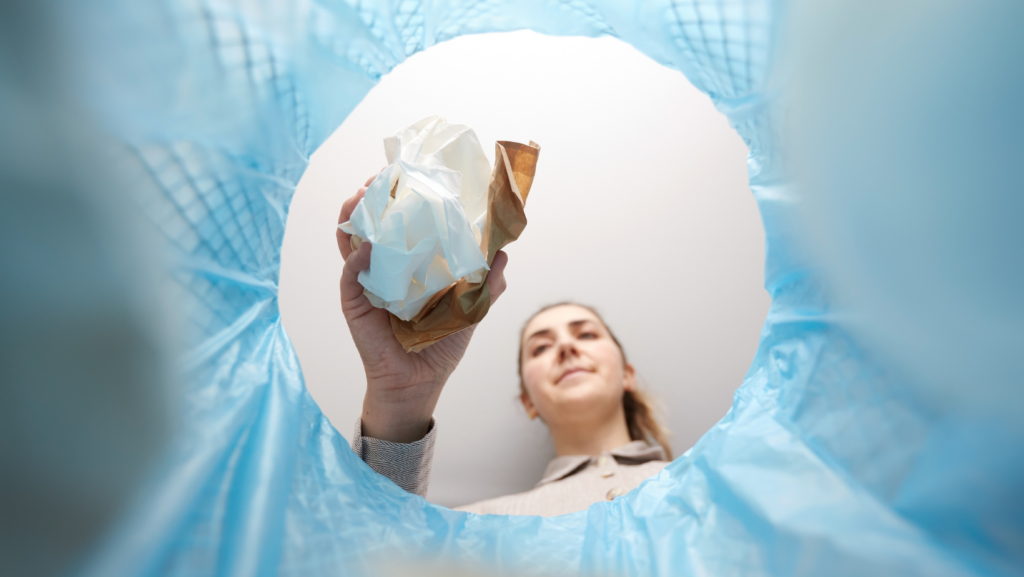
Now that you have successfully removed the dead tick, dispose of it in a container. However, you want to ensure the tick has not transmitted any potential illnesses. In that case, you can keep it in a small Ziploc bag. Drop it off at your vet whenever possible for an examination.
Otherwise, you can just throw away the dead tick in any way you want.
Things To Consider While Removing Ticks Easily From Your Dog’s Skin
Knowing how to do and apply the method is easy, though, while removing ticks from your dog’s skin. However, you need to consider a few things before you start applying the methods. Check out the methods below.
1. Don’t twitch the tick from the sides
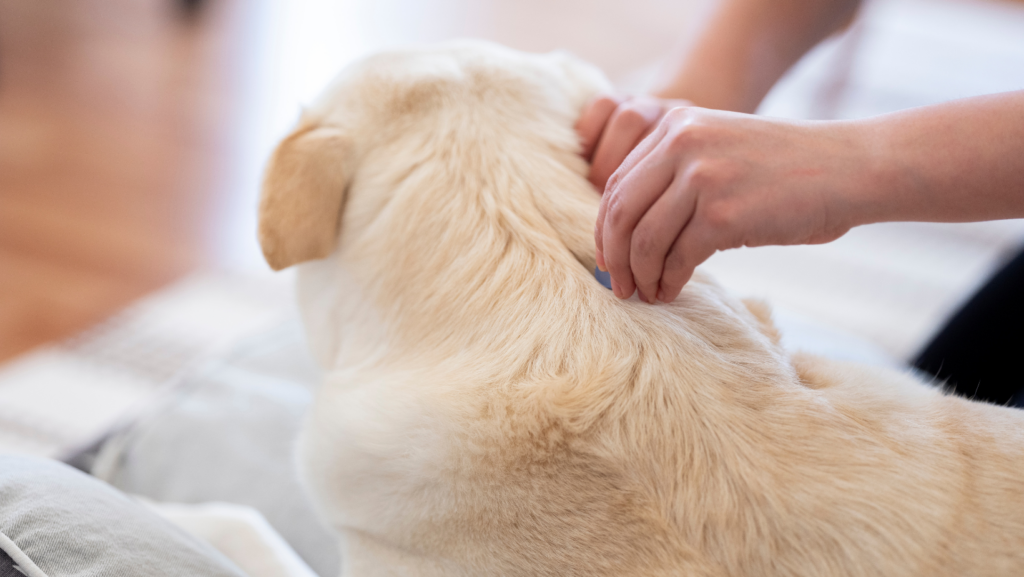
Ticks attach themselves to a dog’s skin very firmly. So avoid twitching them from the sides while trying to eliminate them, as it can lead to two things:
- One, the insects’ bodies can detach from their mouth and head, which stay hooked onto your dog’s skin.
- Secondly, after breaking off, their body can release toxins or bacteria onto the skin, transmitting the disease.
2. Employ The Right Tick Tweezer
The proper tick tweezer is an essential tool that can help to remove ticks safely and effectively from a dog’s skin. Using the wrong type of tweezer or improperly using the right one can cause the tick’s mouthparts to break off, which can lead to infection and other complications. Therefore, selecting the right tick tweezer and using it correctly is crucial for the successful removal of ticks from a dog’s skin.
3. Don’t use nail polish, petroleum jelly, or soap to remove ticks

Do not use certain household items such as nail polish, petroleum jelly, or soap to remove ticks from their skin. These methods are ineffective and can even be harmful, potentially increasing the risk of infection or further aggravating the tick bite. Instead, proper tick removal techniques should be followed, such as using fine-tipped tweezers to grasp the tick as close to the skin’s surface as possible and pulling it out with steady, even pressure.
What To Do If You Can’t Still Remove The Dead Ticks?
Are you still struggling to remove the dead ticks from your dog’s skin? Don’t freak out! Take your furry buddy to the vet for help and professional guidance. They will do a thorough check-up and then carry out the tick-removing process. Professionals have the requisite experience and equipment to eradicate even the most stubborn ticks.
What Happens If the Ticks Aren’t Removed Properly?

f the tick’s head, mouth, or body is still stuck in your pet’s skin, don’t fret. The bacteria that can cause illness are primarily present in the tick’s body. So the chances of the disease being transmitted are less if the body is already removed.
Within a few days, your dog’s body will naturally throw out the tick’s remaining portion. However, in some cases, you may see pus forming in the tick bite area, or it may become inflamed. It’s normal, signifying that the dog’s body is reacting to it as a foreign object.
Until then, you can apply Betadine or Neosporin to the bite area to reduce the redness or itching.
What Should You Do After Removing Dead Ticks From Your Dog?
Once you remove the dead ticks, disinfect the affected area by dabbing it with alcohol. You can apply topical antiseptics like betadine to treat the redness or any redness.
Take your buddy to the vet for a thorough check-up. If tick-borne diseases have been contracted from the parasite, they can start treatment immediately.
However, you should generally keep your buddy up-to-date on tick preventives. It will protect them from further tick infestations. Apart from this, keep your house and yard clean to keep ticks away from your dog.
Note that ticks can’t thrive without water. Thus, avoid leaving non-required water sources open. The surrounding area should be dry before your buddy starts living there.
Is It Necessary To Consult Your Vet After Removing Ticks?

It’s better to consult the vet after completing the tick removal process. While there are several tick species, you will want to confirm whether your dog got infected with any tick-borne diseases. Your vet can help you identify the tick species properly.
Some of the most common species include the American dog tick, deer tick, brown dog tick, and black-legged tick. Your vet will examine your dog’s body and fur precisely for any left-over live or dead ticks. In serious cases, they can shave his entire coat for easy inspection and treatment.
After identifying the tick species, the vet will perform blood and other tests to confirm any tick-borne illnesses contracted in the body. They can decide on a treatment plan accordingly.
Note that tick-borne diseases start showing symptoms after a week or so. Thus, even if the lab tests yield a negative result, you must keep monitoring your pet for symptoms.
Nevertheless, the vet will offer a tick preventive substance, topically or orally, to prevent further infestations.
How To Ascertain If A Tick Is Alive Or Dead?
The best way to ascertain whether the tick is alive or dead is by its legs. The fact is that their head mostly remains buried in the host’s skin.
So if you notice the tick is facing outward, it’s alive. On the contrary, if you notice a contracted body and curled-up legs, the tick is dead.
You can also tell the difference between a live and dead tick by checking if its legs are moving. Alive ticks have moving legs. But you may not understand it at a glance while the tick stays steady in position.
What you can do is touch the tick with your tweezer and see if it’s moving the legs. If the legs move, you will be sure the tick is alive. Dead ticks will have stiff, dried-up bodies.
FAQ’s
Ans: You must have a good grip on the dead tick’s body before pulling it straight out with the tweezer. Be patient, as it can take a few minutes to expel the tick. Moreover, avoid twisting or wiggling the bloodsucker at any time.
Ans: Overstuffed ticks can stay attached to a dog’s skin for nearly 2 to 10 days.
Ans: The tick will die even if the head remains hooked to your dog’s skin. But it may not be the case for all ticks. Some tick species continue to absorb blood to feed themselves before they fall.
Conclusion
Like humans, ticks are also harmful to dogs. A dog can have dead ticks due to anti-tick medications. Although they pose fewer risks, dead ticks can cause skin irritations or other issues. These bloodsuckers stay embedded in a dog’s coat. So they must be removed promptly.
It may initially look intimidating to remove dead, dried ticks from a dog’s skin. But you can remove them easily and effectively with the right procedures, like those mentioned above. However, make sure to wear gloves and use the correct tweezers during the tick removal process.
Meet John Patterson, an accomplished Dog Trainer and a dedicated advocate for building strong human-canine relationships.With years of experience as a Professional Dog Trainer, John firmly believes that well-trained dogs are a reflection of patient guidance and unwavering care. Beyond his training skills, he finds solace in grooming and playing with dogs, nurturing their physical and emotional well-being.

